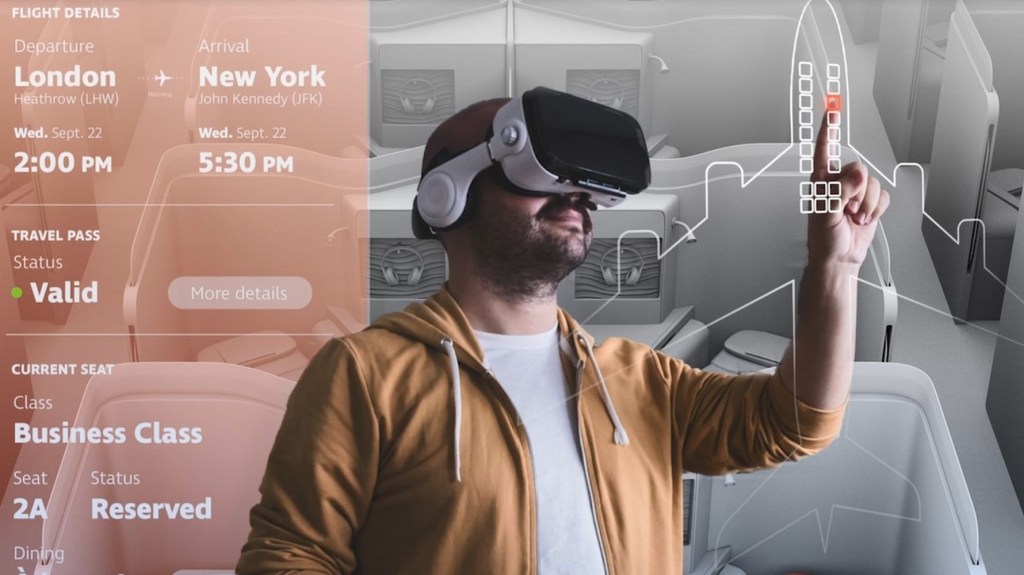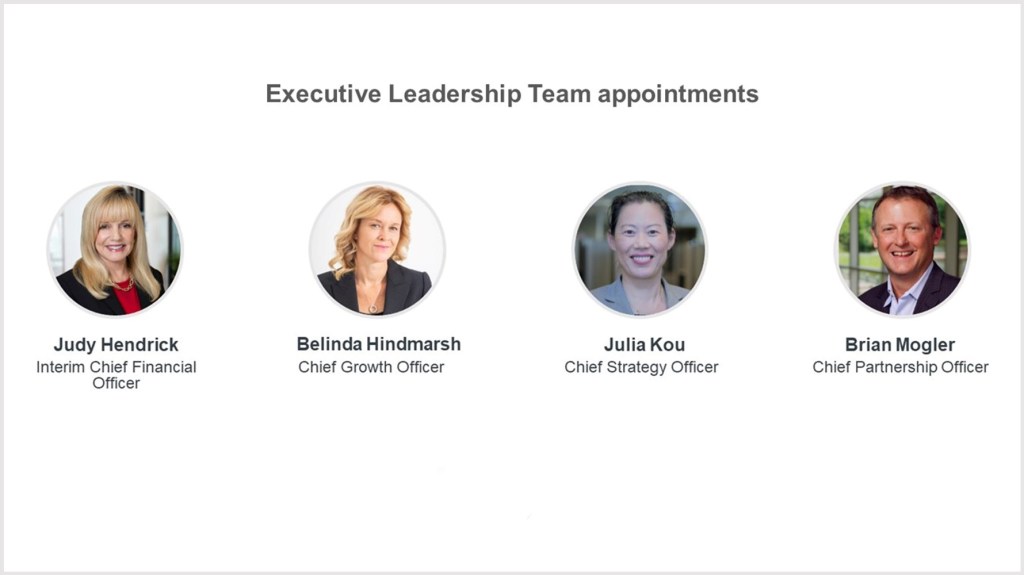Introducing the latest myCWT product and service enhancements
Building on our digital, omnichannel myCWT platform, our new products and services will simplify travel management for you and your employees – anytime, anywhere, anyhow.
Note: Featured services may not be available in your country at this time. Please reach out to your CWT representative for more details.
Hear from Chief Product Officer, Erica Antony as she shares the key product highlights of 2024, along with the key areas driving innovation.
-

2040: Baseline, Boom or Bust
As we enter an era of rapid transformation and unprecedented challenges, it is essential for travel managers, meeting & event planners, and corporate decision-makers to look ahead and frame our current strategic thinking with a clear vision of the future. Business travel and meetings and events (M&E) are poised for significant change over the next decade and a half, driven by a complex interplay of sustainability goals, technological advancements, evolving work models, and geopolitical dynamics.
In this paper to mark the 10th anniversary of our Global Business Travel Forecast, we explore, for the first time, a long-term vision of the future and potential trajectories through three distinct scenarios, each offering insights into how these forces should affect policy-making, budgeting and priorities. By examining these scenarios, we can better understand the diverse possibilities that lie ahead and the strategic imperatives required to thrive in each potential future.
Based on trajectory data analysis and interviews with industry leaders, behaviorists and climate tech founders, this forward-looking approach enables us to anticipate changes, strengthen our strategies, and make informed decisions that align long-term objectives. It is through this lens of foresight and adaptability that we can build resilience, seize opportunities, and navigate the complexities of the future.
We invite you to reflect on the insights presented, and consider how your organization can prepare for the opportunities and challenges that lie ahead. Together we can ensure that travel and meetings remain catalysts for growth, scalability and sustainable practices.
- Scenario development is both an art and a science
- Megatrends Shaping the Future of Business Travel, Meetings and Events
- Sustainability goals the new crux of corporate policy
- Technology Revolutionizes Travel Management
- Modern work models spark new travel patterns
- Changing demographics open doors to new opportunities
- Three Scenarios: Base case, boom and bust
- Future-proofing strategies

-

CWT GBTA Global business travel forecast 2025
When it comes to pricing, global business travel has finally reached an enduring, higher baseline. Prices will continue to rise in 2025, but only moderately, so expect a period of normalized growth.
However, this pricing environment, one of marginal gains and price regularity, is fragile. Global leisure travel has now realized a lot of its pent-up demand, while corporate travel has been resurgent, with 2024 edging at preCovid levels.
There are many factors at play, whether its volatile oil prices, labor costs and constraints, inflationary pressures, and geopolitical factors. As this elevated baseline edges upwards, albeit marginally, travel budgets will come under increased scrutiny, especially as travel patterns and attitudes change.
It’s why business travel can’t be viewed in a silo, and the true value to an organization must be fully realized. This forecast can help with those calculations.

-

Capitalize on emerging technologies in corporate travel
Technological advancements are accelerating at an unprecedented pace. How will emerging innovations like Generative AI, blockchain, and self-sovereign identity (SSI) transform corporate travel?
BTN and CWT probed global CEOs, travel managers, industry consultants and tech experts on the promises, questions, and expectations these innovations raise and how they are set to reshape traveler experience, cost control and service delivery in corporate travel and events.
Download and discover
- The technologies that will have the greatest impact on corporate travel in the next 2-5 years
- How these emerging technologies are poised to control costs, enhance service and security, and boost efficiency
- The critical challenges, opportunities, risks and roadblocks each innovation raises
- What travel managers, buyers and experts anticipate from these innovations

-

Maximizing fund-recovery from pandemic flight cancellations with $3M+ hard-dollar savings

The challenge
CWT’s life sciences customer was very concerned about the risk of the $47.2M spent during the Covid-19 period with airlines. Under financial stress, some airlines implemented refund restrictions.
Given the complexity, traditional refund-tracking technology was not enough to mitigate the financial impact of travel disruption.
The solution
The first step was to validate the exact status of the $47.2M ticket spend using CWT reporting. We then hosted calls with all top 30 airlines to confirm the status of every ticket: used, refunded, or open for follow-up.

With the airlines we agreed to urgently refund open tickets, prioritizing the most expensive. Together with several US airlines, we managed to setup UATP accounts for tickets that would normally expire, to be used at a future date. We presented our progress in monthly dashboards to monitor and adapt as needed.
The result
The value of all tickets issued during the first Covid-19 period was validated and maintained.
The client was able to use or reuse $28.6M worth of tickets issued and received a refund of $15.6M for unused tickets, including negotiations with airlines to release funds.
By having clarity on these categories, CWT and the client team were able to focus efforts on securing $3.0M of funds to be reused via the UATP solution, maintaining the value of expired tickets for direct savings.
-

A highly complex global consolidation: Implementing a single travel policy across 51 countries for the first time

The challenge
Harmonizing a highly fragmented global travel program of $200M+ spend that was split across two primary, and multiple regional, TMCs for a diversified conglomerate specializing in medical products and services.
The solution
The global project was led by a dedicated implementation team consisting of a Global Implementation Manager, Regional Implementation experts and technology resources. This team coordinated and documented all implementation meetings, calls, tasks, and documents in CWT’s project management tool, keeping everyone moving forward. Having resources at both a global and regional level facilitated alignment and coordination for clear communication throughout the project.

A key success factor was the CWT client management team working right alongside the implementation team throughout the project. This ensured consistency of program knowledge through go-live and into a steady state of the new global program.
The result
- 99.1% data accuracy globally via implementation of global travel policy and reporting fields
- Greater supplier leverage and duty-of-care with reduced program leakage and visibility under one TMC
- Consistent traveler experience through global tool settings and programming
-

Queen’s English: 5 inspiring quotes to mark the Platinum Jubilee
American conductor, composer, and humanitarian, Leonard Bernstein, once said: “To achieve great things, two things are needed: a plan and not quite enough time.”
And while there is much truth in that, in the UK and in many parts of the world, people are celebrating and acknowledging the unprecedented achievements of Her Majesty, Queen Elizabeth II during her historic Platinum Jubilee year.
Whether you’re a devoted royalist who would happily camp for days for the best views of the Trooping of the Colour or an anti-monarchist, more likely to be humming the Sex Pistols version of ‘God Save the Queen’ all weekend, most will agree that Queen Elizabeth II has lived a remarkable life of service and integrity, and is a source of inspiration to people around the world.
Many things are and will be written and said – but I thought it perhaps more fitting to look at some of her own inspirational words from her past 70 years as Monarch, and so here are five of my favourite quotations by Her Majesty:
- “When life seems hard, the courageous do not lie down and accept defeat; instead, they are all the more determined to struggle for a better future.”
- “Over the years, those who have seemed to me to be the most happy, contented, and fulfilled have always been the people who have lived the most outgoing and unselfish lives.”
- “I know of no single formula for success. But over the years I have observed that some attributes of leadership are universal, and are often about finding ways of encouraging people to combine their efforts, their talents, their insights, their enthusiasm and their inspiration to work together.”
- “It has always been easy to hate and destroy. To build and to cherish is much more difficult.”
- “Let us not take ourselves too seriously. None of us has a monopoly on wisdom.”
- “When life seems hard, the courageous do not lie down and accept defeat; instead, they are all the more determined to struggle for a better future.”
-

Identifying best-in-class performance: Enabling senior leadership to validate the travel program value and effectiveness

The challenge
One of CWT’s life sciences customers with around $60M in annual spend wanted to move away from the ‘traditional’ data (e.g. ATPs and ARRs) as benchmarking metrics. They asked CWT to provide insight to validate if their policy compliance and spend per employee was in line with peers.
The solution
Working in partnership with the Global Travel Manager, CWT’s highly experienced Business Insight Consulting team created a bespoke benchmarking report. The report included key metrics such as travel spend per employee, spend in comparison to company revenue and R&D budgets; they also included specific metrics such as policy compliance per cabin—all categorized into four distinct industry peer groups.

Customer filters within the report enabled them to drill down within the data to geographical scope, transaction types, issuing periods and air and hotel, or a combination of the two.
The result
The report showed:
- Compliance was best-in-class by cabin
- Spend per employee was healthy compared to industry peers
- Higher spend by revenue was easily explained when comparing pharma company revenue to biotechnology
These findings supported the leadership teams in policy decisions to use travel as an effective means to attract and retain talent.
-

CWT simplifies pricing and billing with new subscription fee model
CWT, the business-to-business-for-employees (B2B4E) travel management platform, has introduced a new subscription fee model to offer its customers simple and transparent pricing and billing. Companies can now receive a single, recurring monthly invoice* covering fees for all the products and services they procure globally from CWT, saving them time, whilst also simplifying their travel cost budgeting.
The subscription fee is based on several criteria, including a company’s forecasted transaction volume and any value-added products and services they may require. The model also offers flexibility, as the fee can be revised if a customer needs to change the scope of products and services included in their subscription.
“As part of our ongoing commitment to simplify business travel for all, this new fee structure will not only streamline our customers’ pricing and billing processes, but afford them built-in volume discounts that are not inherent to the transaction fee model,” said Brady Jensen, CWT’s VP of Finance and Head of Global Pricing. “Different to Transaction Fee Models, this new billing model issues just one simple, comprehensive monthly invoice as opposed to multitudes, making monitoring and managing business travel spend and forecasting that much easier for corporate travel managers.”
CWT has piloted subscription fee billing with a select group of clients over the past year. The feedback has been overwhelmingly positive, providing clarity into their TMC spend as well as significantly reducing the amount of time their finance teams spend reconciling TMC invoices. New clients indicated the model eliminated their biggest billing bugbear of unanticipated or hidden fees, which they had historically experienced prior to joining CWT.
“We are very happy to have switched from the transaction fee model onto the new subscription model,” said Heather Allegrina, Global Travel Manager at ServiceNow, one of the companies to participate in CWT’s subscription program. “It reduces the administrative hassle quite significantly. As a high-growth, global company, it gives us the flexibility and reliability to forecast and measure quickly and easily our travel investment to support our scaling strategy.”
*Except countries with local restrictions
CWT is a leading global partner in business travel, meetings, and events. Operating across six continents, we deliver sustainable, tailored solutions that help organizations connect, engage, and thrive in an evolving world. Our myCWT platform integrates advanced technology with human expertise to simplify travel and enhance traveler and attendee experiences. Extensive global coverage, seamless data integration, AI-driven analytics, and carbon-conscious travel tools enable businesses to optimize their travel and meetings programs while delivering measurable value.
With 150 years of industry experience and a deep commitment to partnership, CWT collaborates with clients to shape the future of business travel and events, making them more efficient, responsible, and impactful.
-

10 tips for planning events for non-event planners from the experts at CWT Meetings & Events
So, you’ve been tasked with planning the next office event. Whether it is the employee summer party or that decisive meeting with a prospective new client, planning events require careful preparation.
How can you ensure your event runs smoothly, especially if you haven’t planned an event before? What should you focus on first? And what should you do if something doesn’t go as planned?
What the experts say
Events are complex. We tend to underestimate the different aspects involved that goes far beyond a room, food and drink. And yet, almost everybody has organized an event at some point in their life. I asked our event planning experts, here is what they say.
1. Time is everything
A good event needs time. Create a timeline of what needs to be done and by when. The longer the lead time the better, as you will get more options for venues, catering etc, better rates and more time to plan properly. Factor in that delays happen, and some processes take longer than expected
2. Budget for your event
If you have been allocated a budget, calculate a spend of around 90% of the total, leaving 10% for unforeseeable situations as they do happen. If you have been asked to put forward a budget, add 10% to the total after itemising all costs, this allows you to have a contingency pot should it be needed.
3. Minimum Guarantee
When negotiating with suppliers, work towards a minimum number of attendees instead of an exact number. For example, if you are planning an event for 80 people, negotiate a minimum of 50, that way you won’t pay for no-shows or last-minute cancellations. Be sure to budget for your maximum numbers though so you’re not caught short.
4. Use registration software
We tend to underestimate the time involved in administrative tasks. Avoid spreadsheet nightmares and hundreds of emails by using attendee management software for registration. That way your attendees register themselves for your event and you keep all your data in one place. One word of warning- be aware of GDPR when managing personal data.
5. Maximize internal talent
Ideal for Christmas parties or other office gatherings, ask around, get to know your colleagues and you may find a budding photographer or a professional DJ that will be keen to be part of your event. The benefits are great specially in low budget events. You improve employee engagement, and that money can be allocated to something else.
6. Music
Music fills rooms and is a good solution to manage “dead times” and create the right atmosphere during transitions, like in coffee breaks. Most hotels have built in infrastructure so you can plug in your playlist directly from your mobile phone.
7. Catering
Have a clear idea of the food you would like to offer and ask for two or three quotes. Be aware of how food is being provided, stored and cooked. Your vendors should have appropriate food hygiene licenses. There are great catering companies with a social component. For small events you can ask restaurants near your offices.
8. Liaise with HR and Health & Safety
If you are holding the event in your office, liaise with Health & Safety and HR asking what you are allowed to do. There are differences in office regulations between countries, and companies may have stricter policies on what is permitted. You may not be allowed to cook or serve food or alcohol on the premises for instance.
9. Identify and manage potential risks
From unexpected rain to a health incident, now more than ever, companies want to have their events under strict control. Create a crisis response plan listing all possible scenarios so you are prepared. Include the names and contact information of those involved in the response.
10. Inspect the venue
Depending on your event, there are many things you should consider. For example, how accessible is the site for people with limited mobility? Will equipment fit through the doors? How accessible is it via public transport? Is there enough parking for people traveling by car? And don’t forget the basics, like air-con and heating, rest rooms and wi-fi connections.
However, if after reading all our tips you feel that you will need a bit of help, get in touch, our teams will be happy to assist with your next event.
Visit CWT Meetings & Events
Image credits: Adobe Stock
-

The Metaverse: The future of business travel?
Preparing for a trip used to mean that you’d pack your overnight bag, ensure you had your printed ticket and passport at the ready, and set your alarm for your early commute to the airport (though undoubtedly following a night of tossing and turning in fear that you’d sleep in). Some of us may think back to those halcyon days with fondness – times when travel seemed simpler and we needn’t think about health passports or long queues through airport security.
But with time – and often necessity – comes innovation. A digitally-connected world has opened virtual doors to a reality where we can be immersed in other worldly experiences without leaving our desk or armchair: The Metaverse.
According to a recent survey of more than 2,500 U.S. adults by Axios, people are more likely to fear the metaverse than be excited about it, with one-third of respondents saying it made them ‘more scared’, and just 7% responding ‘more excited’.
So, how do we alleviate that fear and make the metaverse a less daunting ‘place’? We demonstrate examples of where it could be used in people’s lives to make something simpler, like simplifying travel for instance. So, put on your interactive headset (maybe some glasses or even contact lenses in future) and join us for a business trip like no other.
Pre-trip
Chat interactively with your hologram booking agent who’ll take all the necessary details to book and confirm your trip. They’ll know from past bookings your seat preferences, dietary requirements for your in-flight meal, and even when to advise light and dark periods to sync your circadian rhythm and avoid jet lag on arrival at your destination.
Take a tour of the airport so you can see exactly where to go from drop-off to gate, and check out the amenities as you experience your business class cabin.
You’ve booked. Now what?
How far is your hotel from your meeting venue? Use the metaverse to walk the short distance or hail a cab. Where are the elevators located in the lobby? What’s the view like from your hotel room window? Adding a bit of sight-seeing or extending your trip for bleisure? Check out the local tourist spots and get a feel for the surroundings. All possible to see virtually before you even get there.
Your travel app has shared your itinerary with loved ones already so they know you’ve arrived at your destination. Why not join them in the metaverse and immerse yourself back home for a family dinner or attend that all important recital or sports game. Never miss out on an important occasion while traveling for work again.
After your trip
There might have been some follow-up actions or something you want to clarify after your in-person meeting. Don’t leave it to impersonal emails. Have that next meeting in the metaverse where you can see, sit next to and interact with other attendees no matter where they’re located. You could be back in their virtual offices smelling the same coffee you previously had the pleasure of drinking.
Closing the deal? If you can’t be there in person, a handshake in a virtual world is better than none at all.
The metaverse won’t replace actual travel. We see from the volumes and pent up demand that people are keen to get back on the road. But if it can aid just that little bit in simplifying it then it’s opening up a whole world of difference.
-

The Life of an idea
When it comes to ideas, there are the good, the bad, and the ugly. An idea though, is a very special thing. It can be short lived, or it can carry greater ambitions.
In any case, an idea should never leave you indifferent.
Here at CWT Meetings & Events, we like ideas. Beautiful ideas, those that make you move forward, those that invoke emotion, ideas of success, and everything in between.
The thing with ideas though is that they are only as good as the action that follows. Those that can take an idea and bring it to life are the people who will experience the most success. After all, hundreds of people may have an idea of a teenager attending wizard school during a long train journey – but only one person took the time to write it.
As Creative Director of CWT Meetings & Events, my team and I spend our days cultivating ideas and bringing them to life with action and visibility around all the media channels. This has given me an insight into the life of an idea, and how a single thought can grow into a large-scale event production.
Spirit and culture of the client
Having an idea is great, but you need to make it your own. Therefore, the first thing we do for our clients is to understand the spirit of their company. What are their values, goals, and culture?
This way, we can ensure that the experience we create from an idea is unique and fulfilling what you need. This leads into the why of your idea. Why do you want to run this event? What is the message that you want to convey to your attendees? What experience do you want to create?
In answering these questions and more, we can create the idea that leads into the next stage of the process.
Creating your message through the graphic environment
With a clear picture of this idea, we begin to fuel it with messaging created through the various creative assets we generate. Along with sales, production, and strategic teams, we brainstorm how to convey your idea throughout your event through design and create the concepts that begin the creative process.
Media, formats, production
This is where we determine what media and assets will be best for you. Be it simple graphics, customized garments and take-home items, layouts for a congress booth stall or even VR immersive experiences. These assets are designed and created with your objectives, message and audience in mind.
Bringing the idea to life on D-Day
On the day of your event, this is where you will see your message come to life through our work. Through the mix of technology and human skills, your attendees will experience your message in the graphic environment we have created for you.
Your idea lives on
The emotions felt, experiences had, and memories created are how your memories live on through your attendees who will look back on it fondly for years to come. This is how we measure, among other indicators, the success of an event…
And this is here the most emotional way to guarantee memories and engagement.
Without any doubt!
-

The secret to attract and retain top talent
As business activity continues to recover worldwide, talent attraction and retention are at the top of the agenda for companies. Rachael Sullivan, VP Human Resources at CWT, talks about the future of work, agency culture and how to attract and retain top talent.
What are the biggest challenges for HR departments at the moment?
The global pandemic has created unprecedented challenges for the world of business. More than ever before, people are the crux of an organisation’s makeup, and because of that, the role of the HR department has become – in terms corporate post-pandemic bounce-back – foundational for moving the business forward, ensuring resilience for both the short and long-term.
With this elevated remit, comes three big challenges:
1. Attracting and retaining top talent
HR departments have had to navigate hiring freezes and furloughs at the peak of the pandemic and conversely are now flexing their recruitment muscle and doubling-down on top talent retention measures, as the world opens up, and business travel and in-person meetings and event demand steadily rises. HR departments both in and outside of the events and travel world are having to reevaluate and reconfigure their organisation’s post-pandemic culture, policies, benefits and programs to help attain top talent stickiness, engagement and professional satisfaction post-pandemic.
2. Defining the future of work
It’s no longer about where work gets done, but how, why and even what work gets done. Offices or specific locations are no longer key to retaining knowledge workers. Leaders alongside HR departments who are successfully navigating in this space are looking at the picture in total, not just in small slices. Because notions of tracking productivity, like the number of hours an employee is in the office, is now fundamentally obsolete.
3. Building a strong HR culture
Ensuring employees and talent see their HR departments as the bastions of a motivated, engaged, diverse, inclusive and healthy workforce.
How can you keep your current staff engaged and motivated?
It all starts with being transparent. The leadership should be at the helm of that – providing regular formal and informal company updates on performances and strategy direction. Also think about staff recognition awards. Employees will be more strongly engaged and motivated when they are recognized, rewarded and promoted.
If you build a company culture that is centered around trust and respect and foster open communication at all levels it triggers a strong degree of loyalty which is reciprocated between employees and leaders.
How can companies stand out to attract new talent?
That is definitely culture. This can be hard to discern fully during an interview, but as a fairly new employee to CWT myself, I quickly understood the culture simply by interacting with its employees and leaders throughout the recruitment process. There was such an ease, comfort, enthusiasm, trust and belief in the future from everyone I spoke to. Then, the icing on the cake was the genuine friendliness I experienced from everyone I met. It is both refreshing and notable – as very few companies exude this both up and down the entire organisation.
What are your predictions for the future of recruitment and retention?
I believe we will continue to see across all companies/industries a higher level of employees searching for another job for quite a while. The millions of people who voluntarily quit their jobs since last year to seek for other opportunities even got labeled: ‘The Great Resignation’ – will temporarily disrupt the recruitment and retention process.
It is vital that the immediate manager, in partnership with HR, must dial in the conversation of retention to the individual employee level. Together they should build an understanding of the employee’s mindset through interactive dialogue; to find out who is satisfied, who could be happier, who may be a retention risk. It’s not a complicated equation. In many cases, it simply takes asking an employee the honest questions. For instance: “What could I do to help you experience more happiness/job satisfaction in your role” or “What is one thing I could do to improve your satisfaction and therefore your retention”. Managers would be surprised to learn how willing the employee is to answer those questions. Then, once a leader hears the answer, of course they need to act. These are all activities we strive for at CWT.
Image credits: Adobe Stock
-

Virtual, face-to-face or not at all: Does how we meet matter?
The COVID pandemic has changed the dynamics of business forever.
Video conferencing has seen world-wide adoption and accelerated technology advancement, and virtual group meetings are now an acceptable form of engagement – especially when in a highly creative event environment.
But it is still an artificial way to conduct business – I mean, no one stares directly at your face for the duration of a meeting. Do they? And I miss those casual side comments in a rest break, a privately raised eyebrow which communicates so much, and the shared bonhomie of getting together.
Maybe it is an age thing, but for me meeting in person better helps build trust and teamwork, and is always a more effective way of solving important problems.
I think we will continue to see a balanced blend of working virtually and meeting in-person – as this will enable us to gain maximum efficiency and effectiveness – especially as a way of optimizing event attendance and helping to match sustainability targets. But, as I head off for my first European meeting for over two years, I am pleased to see that I am not alone – a recent research report by tClara says business leaders are more than ready to re-embrace face-to-face meetings.
Also, like those interviewed for the research, I think the most critical travel-related goals should be around achieving more successful trips and protecting each traveler’s health.
Of course we should always assess whether a trip is actually necessary, and 43% of leaders in the research said that that judging the trip’s importance is the best guideline for approving travel when budgets are tight. Interestingly, only 30% say prioritizing customer-facing trips over internal trips is best -engaging with our colleagues is vital following the past two years.
For some people, though, the pandemic has forever changed their personal appetite for business travel, but for corporations I believe it has never been a more critical device to define, differentiate, and deliver success.
Working for one of the world’s largest business travel and meetings companies I accept that I may be slightly biased in my views, so don’t just take my word for it – why not read the report, and see what business leaders are really thinking.
-

Taking the strain out of travel: 12 thoughts on traveler wellbeing
Traditionally travel and events are seen as a positive way to maintain mental balance with stimulation from meeting people, seeing new places, and experiencing new things, all having a positive impact on our general well-being. Mountains of research suggests that regular social interaction is one of the strongest predictors of happiness. Add to that the potential for contemplative downtime when actually travelling, and improvements in handling time zone changes, a refreshing experience should await.
Yet, as we emerge from the past two years of travel inertia, we find a changed world, with inconsistent border entry requirements, uncertainty over rapidly changing regulations, differing provider/accommodation protocols, and a potential nervousness from being in a strange place after such a long period of home life – any of which could be seen to unsettle our travel karma and wellbeing.
So, here are my top 2 main reasons why I believe travel remains just-the-tonic for wellbeing, and 10 travel tips (or travel hacks – as modern parlance dictates) to help relieve any potential stress from your travel and event experience:
2 reasons to travel
- Engaging with different cultures helps you increase empathy towards others, improve tolerance levels, and reduce bias (whether conscious or unconscious).
- A one-hour, face-to-face meeting can replace 20 emails, 10 phone calls, or 5 video conferences.
10 travel hacks
- A thorough checklist will make everything else seem just a little less stressful
- Use your travel time to relax and mentally prepare for your meetings
- Pack essential toiletries rather than buy them enroute
- Whenever possible opt for cabin baggage rather than checking it in
- Make the most of hotel facilities to help acclimatize your body
- Plan for time differences you fly to avoid meeting tiredness and focus wavering
- Always take a bit of cash for emergencies
- Have your travel documents backed up somewhere easy to access
- Be courteous to others – you may have your own focus, but you have no idea what others may be experiencing
- Ensure you have any and all emergency support contacts easily accessible – for added peace of mind
As my father used to say to me whenever I went off on any travel trip: “Travel safe. Travel well.”
-

CWT appoints Belinda Hindmarsh, Brian Mogler and Julia Kou to the Executive Leadership Team, and announces the forthcoming appointment of Judy Hendrick as Interim CFO
CWT, the Business-to-Business-for-Employees (B2B4E) travel management platform, announces the appointments of Belinda Hindmarsh as Chief Growth Officer, and Brian Mogler as Chief Partnership Officer. They, and Julia Kou, CWT’s Chief Strategy Officer will all now report to Patrick Andersen, CWT’s President and CEO, and become members of the company’s Executive Leadership Team, with immediate effect. Additionally, Judy Hendrick has been appointed Interim Chief Financial Officer (CFO) from 1 July 2022, taking over from Bill Courtney, CWT’s current CFO, who has announced his intention to retire at the end of June 2022.
“Appointing a group of such highly talented individuals to our Leadership Team is a strong statement of our intent, a very public commitment to our ambitious growth agenda, and I am delighted to welcome each of them to their new roles,” said Patrick Andersen, CWT’s President and CEO. “I am also very pleased to have secured someone of Judy’s financial acumen and talent to act as Interim CFO, pending a permanent appointment, and thank Bill for the impressive impact he has made while in the role.”
Immediately prior to her appointment as Chief Growth Officer, Belinda Hindmarsh was Chief Operating Officer of RoomIt and China, and she will continue to spearhead these and other commercial developments, plus marketing and communications. She joined CWT in 2018 to lead Global Sales Effectiveness and was appointed SVP Global Market Management & Market Development in 2020. Belinda has over 20 years’ experience in the travel tech space, having held various international and global operations, marketing, supplier management and commercial roles with Expedia Group and Aer Lingus.
Prior to his appointment as Chief Partnership Officer, Brian Mogler was CWT’s Head of Global Supplier Management and Solutions Group, and he retains responsibility for CWT’s Air & Ground Transportation strategy, commercial relationships, revenue and supplier agreements and supplier e-commerce and merchandising strategy. He will also take on responsibility for CWT’s Global Partnership Network and certain technology partners. He has more than 30 years’ travel industry experience, and joined CWT in 2011, having held a variety of management roles at American Express Corporate Card, American Express Business Travel, and United Airlines.
Julia Kou was appointed Chief Strategy Officer in April 2022, and is dedicated to leading corporate strategy, mergers & acquisitions, strategic transactions, business insights & analytics, and is responsible for enabling CWT’s company’s vision and strategic priorities. Prior to this she was Head of Strategy, Planning & Analytics for two years. She is a Board member of JTB Business Travel Solutions Inc., and China Travel Management Services Company Ltd., and joined CWT in 2016 following M&A, capital markets, and legal roles with Capgemini, Travelport, Cendant Travel Distribution Services Group Inc., and Simpson, Thacher & Bartlett LLP.
Judy Hendrick retired as CFO and Chief Growth Officer of Aimbridge Hospitality on 31 December 2021, following 13 years in the role, and she has 20 years of extensive experience in hospitality and banking. She served for 15 years at Wyndham International in various executive roles, including EVP Chief Investment Officer, SVP of Finance, and Treasurer, before which she held senior positions at Chase Manhattan Bank, Canadian Imperial Bank of Commerce and First Republic Bank. She serves on the American Hospitality & Lodging Association’s Women in Lodging Advisory Board, the American Heart Association Board of Directors for the Southwest Region, and on the Executive Committee of the Dallas Chamber of Commerce Executive Women’s Roundtable.
Global executive search firm, Korn Ferry, has been appointed the remit to find a permanent candidate for the CFO role.
CWT is a leading global partner in business travel, meetings, and events. Operating across six continents, we deliver sustainable, tailored solutions that help organizations connect, engage, and thrive in an evolving world. Our myCWT platform integrates advanced technology with human expertise to simplify travel and enhance traveler and attendee experiences. Extensive global coverage, seamless data integration, AI-driven analytics, and carbon-conscious travel tools enable businesses to optimize their travel and meetings programs while delivering measurable value.
With 150 years of industry experience and a deep commitment to partnership, CWT collaborates with clients to shape the future of business travel and events, making them more efficient, responsible, and impactful.